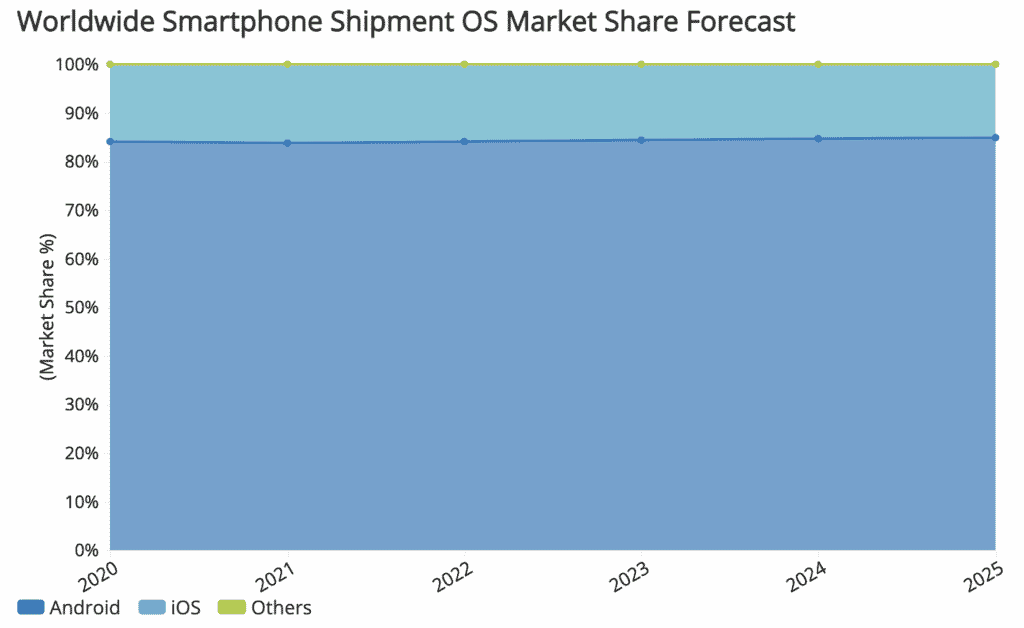What are Examples of Mobile Operating Systems?
When you purchase a mobile device the manufacturer will have chosen the operating system for that specific device. Often, you will want to learn about the mobile operating system before you purchase a device to ensure compatibility and support for the mobile applications you want to use.
To learn more about Mobile App Development, check out these courses on TechRepublic Academy.
In this definition...
9 Popular Mobile Operating Systems
1. Android OS (Google Inc.)
The Android mobile operating system is Google’s open and free software stack that includes an operating system, middleware, and key applications for use on mobile devices, including smartphones. Updates for the open source Android mobile operating system have been developed under “dessert-inspired” version names (Cupcake, Donut, Eclair, Gingerbread, Honeycomb, Ice Cream Sandwich), with each new version arriving in alphabetical order with new enhancements and improvements.
2. Bada (Samsung Electronics)
Bada is a proprietary Samsung mobile OS that was first launched in 2010. The Samsung Wave was the first smartphone to use this mobile OS. Bada provides mobile features such as multipoint-touch, 3D graphics, and of course, application downloads and installation.
Did You Know ? In the computer industry, proprietary is the opposite of open. A proprietary design or technique is one that is owned by a company. It also implies that the company has not divulged specifications that would allow other companies to duplicate the product.
3. BlackBerry OS (Research In Motion)
The BlackBerry OS is a proprietary mobile operating system developed by Research In Motion for use on the company’s popular BlackBerry handheld devices. The BlackBerry platform is popular with corporate users as it offers synchronization with Microsoft Exchange, Lotus Domino, Novell GroupWise email, and other business software when used with the BlackBerry Enterprise Server.
4. iPhone OS/iOS (Apple)
Apple’s iPhone OS was originally developed for use on its iPhone devices. Now, the mobile operating system is referred to as iOS and is supported on a number of Apple devices including the iPhone, iPad, iPad 2, and iPod Touch. The iOS mobile operating system is available only on Apple’s own manufactured devices as the company does not license the OS for third-party hardware. Apple iOS is derived from Apple’s Mac OS X operating system.
5. MeeGo OS (Nokia and Intel)
MeeGo OS is a joint open source mobile operating system, which is the result of merging two products based on open source technologies: Maemo (Nokia) and Moblin (Intel). MeeGo is a mobile OS designed to work on a number of devices, including smartphones, netbooks, tablets, in-vehicle information systems, and various devices using Intel Atom and ARMv7 architectures.
6. Palm OS (Garnet OS)
The Palm OS is a proprietary mobile operating system (PDA operating system) that was originally released in 1996 on the Pilot 1000 handheld. Newer versions of the Palm OS have added support for expansion ports, new processors, external memory cards, improved security, and support for ARM processors and smartphones. Palm OS 5 was extended to provide support for a broad range of screen resolutions, wireless connections, and enhanced multimedia capabilities and is called Garnet OS.
7. Symbian OS (Nokia)
Symbian is a mobile operating system (OS) targeted at mobile phones that offers a high-level of integration with communication and personal information management (PIM) functionality. Symbian OS combines middleware with wireless communications through an integrated mailbox and the integration of Java and PIM functionality (agenda and contacts). Nokia has made the Symbian platform available under an alternative, open and direct model to work with some OEMs and the small community of platform development collaborators. Nokia does not maintain Symbian as an open source development project.
8. webOS (Palm/HP)
WebOS is a mobile operating system that runs on the Linux kernel. WebOS was initially developed by Palm as the successor to its Palm OS mobile operating system. It is a proprietary Mobile OS which was eventually acquired by HP and now referred to as webOS (lower-case w) in HP literature. HP uses webOS in a number of devices including several smartphones and HP TouchPads. It has pushed its webOS into the enterprise mobile market by focusing on improving security features and management with the release of webOS 3.x. HP has also announced plans for a version of webOS to run within the Microsoft Windows operating system and to be installed on all HP desktop and notebook computers in 2012.
9. Windows Mobile (Windows Phone)
Windows Mobile is Microsoft’s mobile operating system used in smartphones and mobile devices with or without touchscreens. The Mobile OS is based on the Windows CE 5.2 kernel. In 2010, Microsoft announced a new smartphone platform called Windows Phone 7.
Did You Know…? According to data from the International Data Corporation (IDC), smartphone companies shipped a total of 313.2 million devices during Q2 2021 with nearly all of that volume running either the Android or iOS platforms.

Image Source: Smartphone Shipment Mobile OS Market Share Forecast, July 2021 (IDC)
Mobile operating system FAQ
Can operating systems of mobile devices support full scale software programs like Microsoft Word or Excel?
Most mobile device operating systems do not support the same software programs available on laptop and desktop computers. The only way to access these applications is to download a mobile version or access the web app version. Microsoft Word, for example, has mobile applications available for Android and iOS devices. Alternatively, users can also access Microsoft Word by logging into the web app from a mobile device’s web browser.
How many mobile operating systems are there?
The majority of mobile devices on the market today use Android or iOS operating systems. A much smaller proportion (>2%) of mobile devices use operating systems from their respective manufacturers, primarily Samsung, Blackberry, and Nokia.

